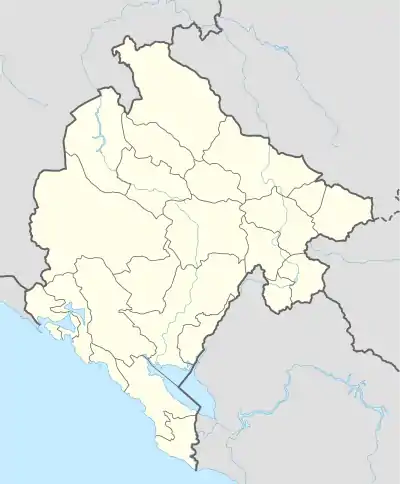Brskovo
Brskovo (Брсково) (German: Biersgau, in old local German records Byrsgaw) is a village in northern Montenegro, within the Municipality of Mojkovac which used to have silver mines and a mint. Brskovo encompasses the whole complex of smaller localities, today overgrown with dense wood and weeds, between the Rudnica and Bjelojevići, the tributaries of the Tara River.
Brskovo
Брсково | |
|---|---|
Village | |
 Brskovo Location within Montenegro | |
| Coordinates: | |
| Country | |
| Municipality | |
| Population (2011) | |
| • Total | 222 |
| Time zone | UTC+1 (CET) |
| • Summer (DST) | UTC+2 (CEST) |

History
Brskovo was first mentioned between 1219 and 1228, in a trade charter of Stefan the First-Crowned, addressed to the Republic of Ragusa.
The Latin name for Brskovo was Brescoa, and it used to be the centre of a district. Having been regularly visited by merchants from Kotor and Dubrovnik, this town with the Virgin's church administered by the Dominicans from Dubrovnik, had been at its zenith in the 1280s, while from 1350 onwards, it completely declined. As a mine, Brskovo was established by the Saxons inhabiting this area. They had their prince and Catholic priests. During its golden age, at the time of Stefan Uroš I, a customs office existed in Brskovo as well as, a century later, a consulate of Dubrovnik. Money called «Grossi de Brescova» was minted in Brskovo. Dante in his Paradiso mentions the mines and mint in Chapter XIX, pp. 139-141.
In 1399, the Turks took Brskovo, and according to Dubrovnik sources, in 1433 it was an abandoned place.
On the whole inland territory of present-day Montenegro, Brskovo was the only commercial centre whose importance could measure up to that of the coastal towns. Not even coastal towns could boast about such value of production and income.
At a dominant position, remains of a fortification – Hill-fort– i.e. a town controlling nearby and the more distant area is situated.
Demographics
According to the 2011 census, its population was 222.[1]
| Ethnicity | Number | Percentage |
|---|---|---|
| Montenegrins | 106 | 47.7% |
| Serbs | 96 | 43.2% |
| other/undeclared | 20 | 9.0% |
| Total | 222 | 100% |
References
- "Tabela N1. Stanovništvo prema nacinalnoj odnosno etničkoj pripadnosti po naseljima, Popis stanovništva, domaćinstava i stanova u Crnoj Gori 2011. godine" (in Montenegrin). Statistical Office of Montenegro. Retrieved January 27, 2012.
- Historical Lexicon of Montenegro, Book 1, - "Daily News-Press", 2006.